October 10-17, 2001
The Big Travelogue: Part Seven
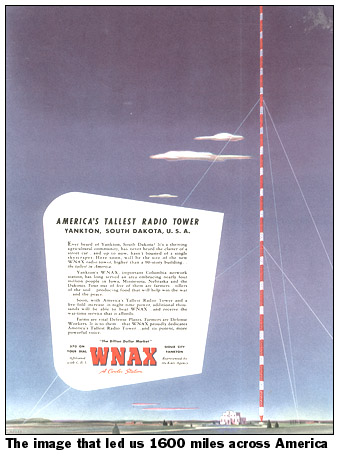 There's
nothing like a good road trip to get a feel for the state of
radio these days. From June 23 until July 7, your editor (accompanied
by Boston Radio Archives creator Garrett Wollman) hit the road
to see what's on - and in - the air across a broad swath of mid-America. There's
nothing like a good road trip to get a feel for the state of
radio these days. From June 23 until July 7, your editor (accompanied
by Boston Radio Archives creator Garrett Wollman) hit the road
to see what's on - and in - the air across a broad swath of mid-America.
For the next few installments of Site of the Week, we'll be
recapping the many highlights of what we like to think of as
The Big Trip, 2001 edition. Come along...
Click
here for part one
Click
here for part two
Click
here for part three
Click
here for part four
Click
here for part five
Click
here for part six
Friday, June 29 - When we packed up the rental car
for our journey, we brought along what amounted to an iconic
image: an old trade magazine ad that's been on the walls of the
NERW Home Office for years. The image, an artist's rendition
from 1942, shows the tower, then under construction, of WNAX,
Yankton, South Dakota.
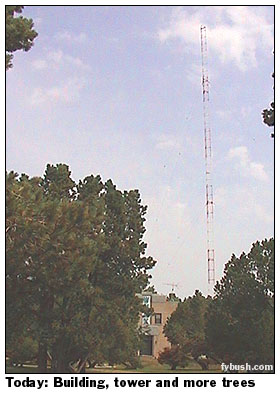 The
copy reads: "Ever heard of Yankton, South Dakota? It's a
thriving agricultural community, has never heard the clatter
of a street car...and up to now, hasn't boasted of a single skyscraper.
Here soon, will be the site of the new WNAX radio tower, higher
than a 90-story building...the tallest in America. Yankton's
WNAX, important Columbia network station, has long served an
area embracing nearly four million people in Iowa, Minnesota,
Nebraska and the Dakotas. Four out of five of them are farmers...tillers
of the soil...producing food that will help win the war...and
the peace. Soon, with America's Tallest Radio Tower and a five-fold
increase in night-time power, additional thousands will be able
to hear WNAX...and receive the war-time service that it affords.
Farms are vital Defense Plants. Farmers are Defense Workers.
It is to them...that WNAX proudly dedicates America's Tallest
Radio Tower...and its potent, more powerful voice. "The
Billion Dollar Market" 570 on your dial WNAX Sioux City
Yankton Affiliated with C.B.S. Represented by the Katz
Agency A Cowles Station" The
copy reads: "Ever heard of Yankton, South Dakota? It's a
thriving agricultural community, has never heard the clatter
of a street car...and up to now, hasn't boasted of a single skyscraper.
Here soon, will be the site of the new WNAX radio tower, higher
than a 90-story building...the tallest in America. Yankton's
WNAX, important Columbia network station, has long served an
area embracing nearly four million people in Iowa, Minnesota,
Nebraska and the Dakotas. Four out of five of them are farmers...tillers
of the soil...producing food that will help win the war...and
the peace. Soon, with America's Tallest Radio Tower and a five-fold
increase in night-time power, additional thousands will be able
to hear WNAX...and receive the war-time service that it affords.
Farms are vital Defense Plants. Farmers are Defense Workers.
It is to them...that WNAX proudly dedicates America's Tallest
Radio Tower...and its potent, more powerful voice. "The
Billion Dollar Market" 570 on your dial WNAX Sioux City
Yankton Affiliated with C.B.S. Represented by the Katz
Agency A Cowles Station"
That's a lot of billing for one small-town radio station to
live up to, and our expectations are high as we make the drive
down highway 50 from our overnight stop in Vermillion to America's
Tallest Radio Tower (well, these days, America's Tallest AM Radio
Tower, anyway).
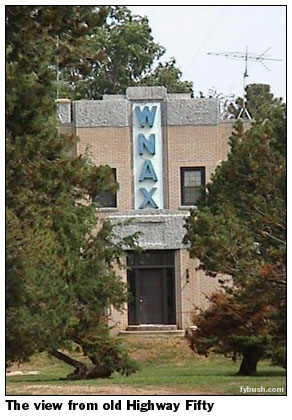 We
know that WNAX, now owned by Saga, is still an important farm
voice with an amazing reach (thanks to its low dial position
and the unbelievable ground conductivity out here) that made
it audible days earlier, as far out as eastern Iowa. But can
the transmitter site live up to the hyperbole of 1942? We
know that WNAX, now owned by Saga, is still an important farm
voice with an amazing reach (thanks to its low dial position
and the unbelievable ground conductivity out here) that made
it audible days earlier, as far out as eastern Iowa. But can
the transmitter site live up to the hyperbole of 1942?
Well, nothing can be as tall as that tower in the ad, which
stretches clear off the page. But at well over 800 feet, the
WNAX tower really is still the tallest AM tower in the country,
though its wide faces make it appear a bit stubbier than it really
is.
We miss a turn or two off highway 50 as we approach Yankton,
but soon enough we're on "old highway 50," a mile or
so north of the new alignment, pulling up the driveway into the
WNAX transmitter site.
First surprise: the treeless landscape of the 1942 ad now
boasts some very mature trees, blocking our initial view of the
transmitter building.
Second surprise: there are three towers here, pulling in WNAX's
night signal from co-channel stations in Dallas (back then it
was the other half of the share-time WBAP/WFAA that also used
820; today it's KLIF) and elsewhere.
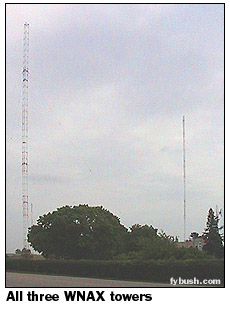 Third
surprise: bugs, everywhere, biting us as we walk through the
trees for a better view of the building, little changed from
its appearance in the '42 ad. Third
surprise: bugs, everywhere, biting us as we walk through the
trees for a better view of the building, little changed from
its appearance in the '42 ad.
Fourth, and best, surprise: there's a truck in the driveway
on the side of the building, and a real live engineer in the
garage. We show him the Iconic 1942 Advertisement as we walk
around the side of the building: "Looks like we found it!"
He likes the ad, and we're invited in for a tour, beginning
in the back room, where a stairway leads up to the engineer's
living quarters on the second floor. The old meter panels from
WNAX's original 5 kW transmitter are still on the wall back here,
too.
Walking towards the front of the building, on the right we
see a small room filled with old radios, articles about WNAX
and other memorabilia. We could easily spend some serious time
here, but the transmitter room awaits. A half-dozen antique chairs
are lined up in the middle of the room, but the real history
is on the edges.
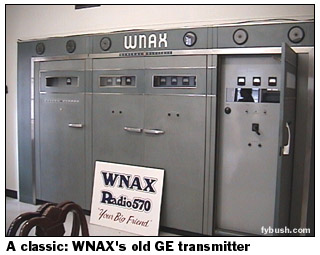 This
old General Electric beast doesn't operate anymore, but it sure
is nice to look at, isn't it? This
old General Electric beast doesn't operate anymore, but it sure
is nice to look at, isn't it?
The sign in front reads "Your Big Friend," a slogan
WNAX used for years.
(You can see a few of the antique chairs at the bottom left
of this picture, if you look carefully...)
Across the room sit the phasor for WNAX's directional nighttime
operation and a backup Harris Gates Five transmitter, and mounted
on the wall above we see a spare-tire cover with a WNAX logo
on it, a promotional item we don't see much back east.
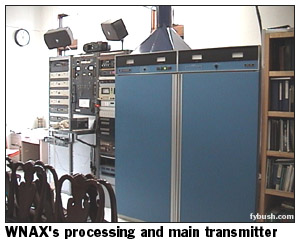 The
Harris MW5 sits along the front wall, between the two other transmitters
and next to the processing rack that's full of all sorts of goodies,
including some processors that are no longer used and an AM stereo
generator that was turned off some time ago. The
Harris MW5 sits along the front wall, between the two other transmitters
and next to the processing rack that's full of all sorts of goodies,
including some processors that are no longer used and an AM stereo
generator that was turned off some time ago.
Could our day get any better? Sure...when the engineer offers
to call down to the studio and arrange a visit for us over there
as well!
We say our goodbyes and are presented with official WNAX Gimme
Caps that proceed to grace our heads (well, mine, anyway) for
much of the remainder of the trip, and it's off to downtown Yankton
and visit to WNAX's studios. Actually, we're not quite to downtown
yet: WNAX's 1930s-era studios burned down in 1982, and the station
rebuilt in a building on highway 50 east of town.
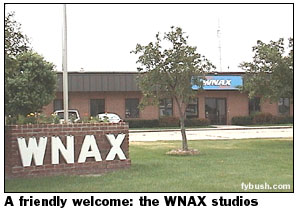 Walking
in the front door, we're greeted by a case full of more WNAX
memorabilia, pretty much anything that survived the 1982 fire
and some items that were donated later on. It's flanked by two
huge picture windows framing two of the biggest air studios we've
ever seen. Walking
in the front door, we're greeted by a case full of more WNAX
memorabilia, pretty much anything that survived the 1982 fire
and some items that were donated later on. It's flanked by two
huge picture windows framing two of the biggest air studios we've
ever seen.
After a nice long chat with the receptionist, we're taken
on a tour of the facility, in which it's explained that the studios
were rebuilt in 1982 to be the same size as the old ones downtown
-- and those were built to accomodate live orchestra broadcasts,
including the house band of the era led by a young man from North
Dakota by the name of Lawrence Welk!
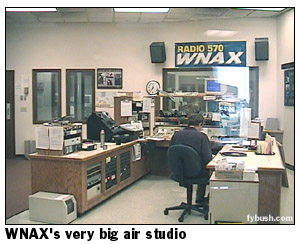 A well-organized
rack room sits at the back of the building, with a hallway running
along the rear of the building past the farm department offices
(farm news takes up much of WNAX's schedule, and it has its own
staff separate from the main WNAX news staff) and the little
studio of WNAX-FM. A well-organized
rack room sits at the back of the building, with a hallway running
along the rear of the building past the farm department offices
(farm news takes up much of WNAX's schedule, and it has its own
staff separate from the main WNAX news staff) and the little
studio of WNAX-FM.
Yes, WNAX-FM, with 100 kilowatts on 104.1, is decidedly the
second fiddle to the AM out here. It simulcasts the AM morning
show and runs voice-tracked country music the rest of the day
from a very small room off the big production studio. The AM,
with its occasional country song slipped in amidst farm reports,
news headlines and five-state weather, is the undisputed king
here, and for good reason: this station has an incredibly loyal
audience that's been listening for decades.
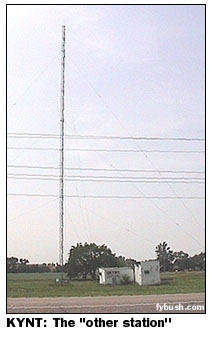 We'd love to stay
for days and visit with the friendly folks at WNAX, but we need
to get to Omaha by evening, so it's down highway 50 we go to
see the rest of Yankton. We'd love to stay
for days and visit with the friendly folks at WNAX, but we need
to get to Omaha by evening, so it's down highway 50 we go to
see the rest of Yankton.
(Yes, there is a rest of Yankton!)
The other station on the Yankton dial is at 1450, KYNT, with
a kilowatt from a typical graveyard tower on the west side of
town.
It's notable mainly for one alumnus, a young man from Yankton
who worked in the newsroom here in the fifties before moving
on to TV jobs in Omaha and Chicago. You might have heard of him...the
name is Tom Brokaw.
(In fact, Brokaw and his wife Meredith were in Yankton the
day before, donating a quarter-million dollars to the town and
dominating the headlines in the local paper and on WNAX and KYNT.
Sorry we missed you, Tom!)
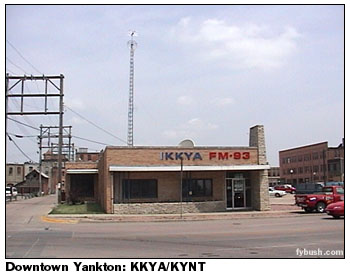 We found the KYNT
studios at the south edge of downtown, along with sister station
KKYA (93.1, aka "KK93"). We found the KYNT
studios at the south edge of downtown, along with sister station
KKYA (93.1, aka "KK93").
A block away, the US 81 bridge carries us over the river,
out of South Dakota and into Nebraska.
A little while later, we see the KKYA tower, an unexciting
stick just east of the highway.
(WNAX-FM is also on the Nebraska side, but it's far to the
east of us on back roads, so it won't be part of this agenda,
alas...)
The radio dial's pretty empty here, but we can already hear
stations from our next destination, the little town of Norfolk.
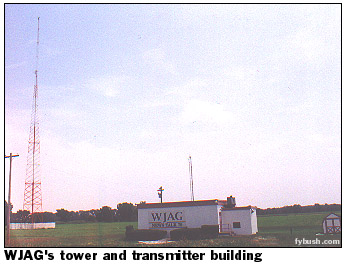 Norfolk is another
town with an old "W" station (remember, the K/W dividing
line used to be on the western edge of the Dakotas, Nebraska,
Kansas, Oklahoma and Texas!) from the twenties. Norfolk is another
town with an old "W" station (remember, the K/W dividing
line used to be on the western edge of the Dakotas, Nebraska,
Kansas, Oklahoma and Texas!) from the twenties.
WJAG is a daytimer on 780, but it might once have been something
bigger. You see, that 780 frequency (770, in the days before
NARBA) was Chicago's clear channel for WBBM - but it was also
in use in Lincoln, Nebraska, where station KFAB managed to operate
at night by setting up a synchronous link to WBBM. After dark,
both stations simulcast CBS network programming and even shared
IDs through the 1930s. WJAG, meanwhile, was operating on 1090
kHz, a relatively open channel. After NARBA, KFAB arranged a
trade with WJAG: it would move to 1110 kHz, where WJAG would
have gone, while WJAG could get the 780 frequency for daytime
use, with the improved coverage the lower frequency offered.
Thus it was that KFAB, later moved to Omaha, became a 50 kW powerhouse
while WJAG remained a little operation in tiny Norfolk.
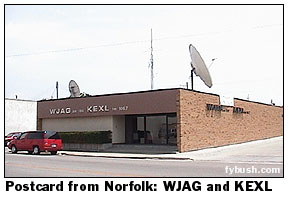 WJAG has one claim
to fame: Norfolk's most famous native son, Tonight Show host
Johnny Carson, once worked here, I believe. WJAG has one claim
to fame: Norfolk's most famous native son, Tonight Show host
Johnny Carson, once worked here, I believe.
In any case, we see the downtown studios of WJAG and its FM
sister, KEXL (106.7) and of FM competitor KNEN (94.7) before
heading down US 275 for the long drive towards our weekend (non-radio)
engagement in Omaha.
There's one more stop along the way, albeit a brief one: the
small town of West Point has a fairly recent pair of radio voices.
AM 840 signed on there in the eighties as a daytimer called KWPN.
Those calls moved to an even newer FM sister on 107.9, and 840
became KTIC. Those stations are now siblings to the better-known
KRVN in Lexington, Nebraska, which Garrett would visit a couple
of days later. (We'll try to get him to offer a special "guest"
Site of the Week on his weekend expedition to western South Dakota
and Nebraska once we finish this series!)
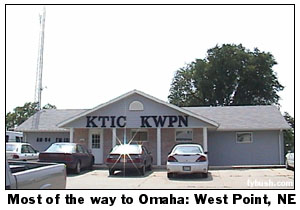 We
don't find the single KTIC stick south of town, but we do see
the stations' studios on the highway as we pass through. We
don't find the single KTIC stick south of town, but we do see
the stations' studios on the highway as we pass through.
Next stop on our trip: the many fine sites of lovely Omaha...coming
to this space next Wednesday! Stay tuned...
If you enjoy Site of the Week on the Web, we're hoping you'll
love our Tower Site 2002 Calendar!
This full-color calendar will feature a dozen of our favorite
sites, including several from last summer's Big Trip - not to
mention monthly calendars that include all the really important
dates like WHAM's 80th anniversary and Edwin Armstrong's birthday.
If you're a regular Site of the Week reader, we have a feeling
you'll have to have the calendar, too. We'll print only enough
to fill orders received by October 29, so don't delay! The Tower
Site 2002 calendar is $15 postpaid to US addresses, US$20 postpaid
to Canada (New York residents please include appropriate sales
tax) and will be shipped in late November, just in time for holiday
gifts for that special radio-obsessed someone.
Please make your checks or money orders payable to "Scott
Fybush" (that would be me), and send them to 92 Bonnie Brae
Avenue, Rochester NY 14618-1802 - and we'll make sure you have
something of beauty on your wall all year long!
(Best of all, buying a Tower Site Calendar helps provide us
with the funds needed to keep Site of the Week coming to you
all year long. If you think that's a good thing, then that makes
this a good cause, right?)
|
